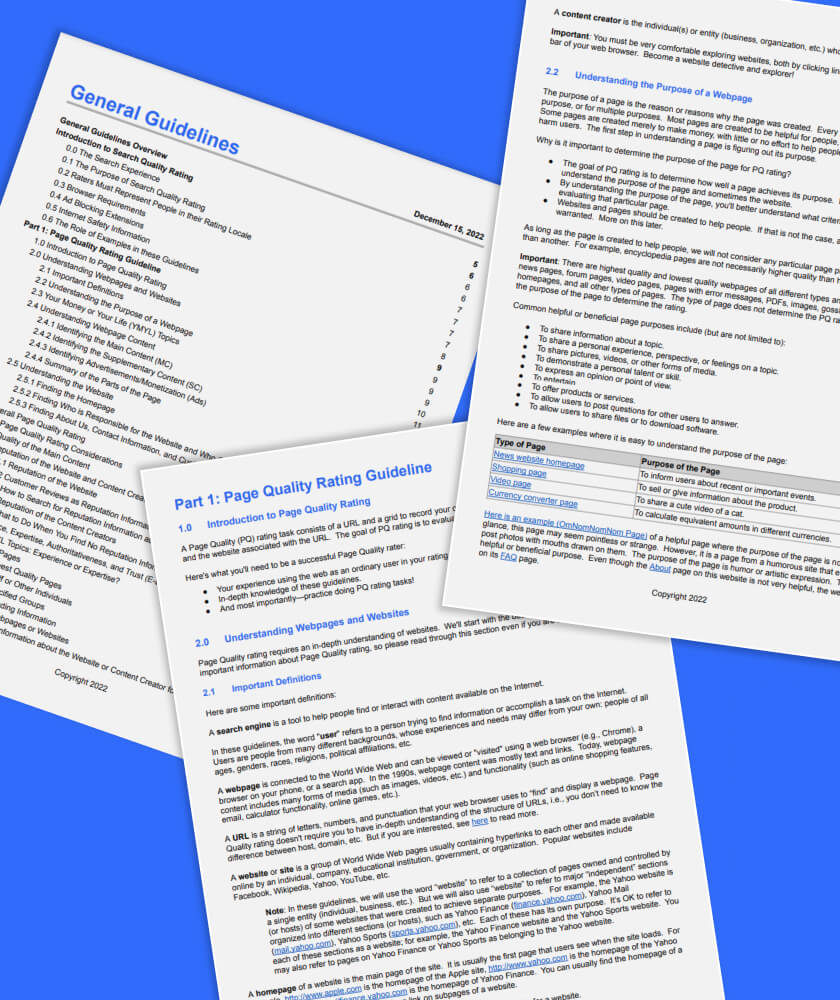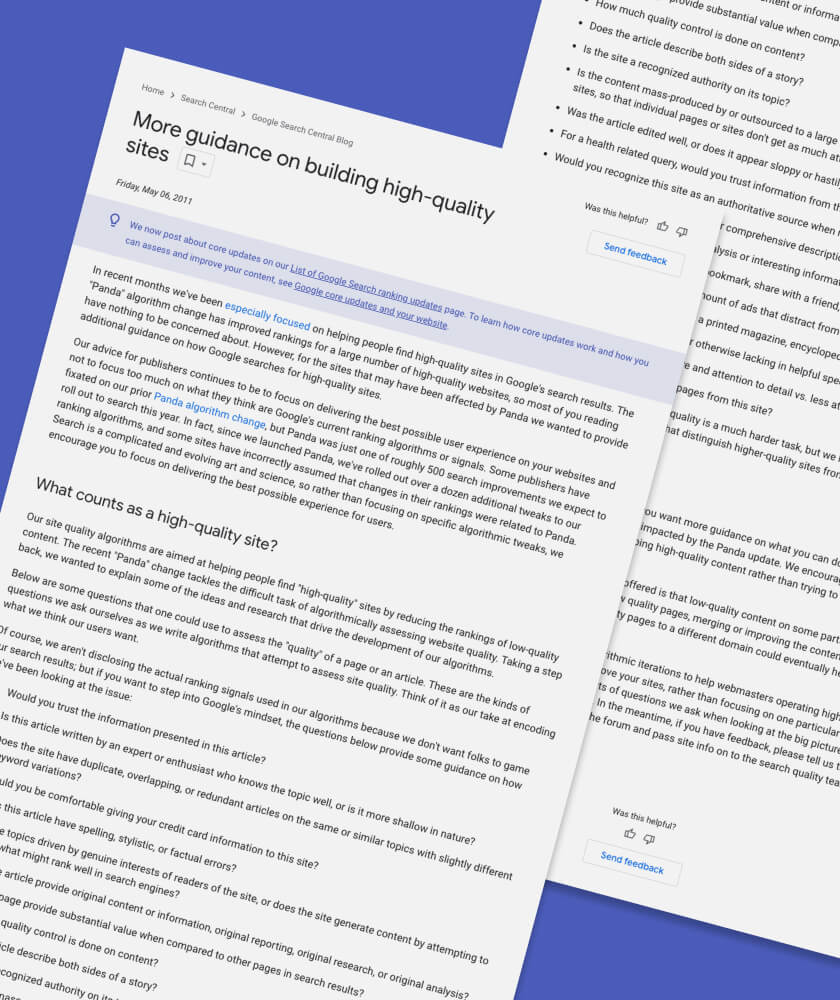Find out what criteria Google applies to evaluate whether or not a piece of content is of quality.

Google has never made any secret of its efforts to adopt effective criteria in evaluating the quality of content, with the aim of returning the most suitable content in the serp (the search results page) to meet users' needs. But the concept of quality for Google may differ from the one we apply for ourselves.
How Google assesses quality
Google's Quality Rater Guidelines provide instructions to Quality Raters (the individuals charged with testing the results offered by Google) on how to assess the quality of websites. The goal of these recommendations is to refine Google's search algorithm and ensure an ever-improving search experience for users. Applying these guidelines as a reference, quality assessors perform random checks to see if the websites displayed in search results are relevant and useful to users.
Under the Page Quality Rating Considerations heading of the Google Quality Rating Guidelines we find indication of factors to be considered for quality:
- the purpose of the page
- the topic of the page and whether it falls into the YMYL (Your Money, Your Life) areas
- the type of website the information provided
- the title of the page the role of the ads on
- the page the reputation of the website and the content creator the fulfillment of E-E-A-T (Experience, Expertise, Authoritativeness, Trustworthiness) criteria.

Quality is a major factor influencing almost every aspect of search, according to a recent discussion between John Mueller and Gary Illyes of Google's Search Relation Team. Content quality does not automatically affect ranking, but it does affect how Google interacts with a site, from sitemaps to direct ranking factors.
In addition to this, we can also deduce a number of pointers on how to approach different aspects regarding the concept of "quality according to Google." Different parts of the site may be of different quality than others, and lower quality may correspond to a lower crawl rate.
Affiliate links are not a problem if the associated content is unique and valuable If low-quality content is removed from the site, the rest of the site may benefit However, according to John Mueller in one of his tweets, "content that contains a lot of information may be of high quality to users but still remain of little value to the web." The concept of quality by web standards may thus differ from what our common sense suggests.
What are the factors behind quality for Google
In 2011, Google had already expressed some guidelines for creating high-quality sites, among which we find:
- it conveys trust to the reader
- it is created by an expert or enthusiast who knows the topic well
- it does not contain duplicate or redundant content that is poorly differentiated
- it does not contain spelling errors
- topics are made on the basis of readers' actual interests and not for the purpose of obtaining rankings
- it contains original information
- the page is more useful than others in the search results
- it offers more than one point of view regarding a news item
- the site is recognized as an authority on the subject it covers

In addition to those listed above, there are other criteria that always revolve around the concepts of competence, authority and quality, to which experience has recently been added. The E-E-A-T- model is now part of the new guidelines for research quality evaluators. They emphasize how critical it is to create content that is original and valuable to the audience.
Google quality raters use these guidelines to evaluate the performance of different search ranking systems, but they do not directly impact ranking. As an aside, they can also be useful to content authors who want to get an idea of the characteristics that content must have to be successful in Google Search.
Content length
A widespread belief in web marketing is that content consisting of many words has a better chance of ranking better than shorter content.
First, the concept of extended length varies widely by industry, and a sea of words is not always more useful than a concise resource. If we are looking for an in-depth essay on the discovery of America or a thorough guide to the workings of the internal combustion engine, it is legitimate to expect in a comprehensive resource a long, in-depth text that dissects the topic in all its major points. If we want to figure out how to change the password on our Wordpress site, an article thousands of words long is likely to waste our time unnecessarily and make us leave the site: much better in this case is a concise step-by-step guide accompanied by pictures and clear directions. Moreover, John Mueller, Google's Webmaster Trends Analyst, revealed in August 2019 that "word count is not a ranking factor."
In any case, the Quality Rater Guidelines do not include counting the number of words in a piece of content: if they don't care about it, why should you?
Relevance to purpose
Every Web site must have a purpose. It doesn't matter what that goal is; what matters is the added value that is created through the site for the user. If a website provides no added value or has the potential to cause harm to the user, it will be ranked with the worst quality level.
In its guidelines, Google states that the main purpose of content should be "to provide information that someone is looking for." Your quality resource therefore should: accurately and concisely address a broad audience get straight to the point avoid obscure references that someone would not perceive eliminate sources of confusion
Eliminate low-quality content
We have seen that high quality is not automatically synonymous with better ranking. On the contrary, low quality is easily synonymous with bad rankings, if not outright penalizations. Therefore, understanding what criteria make a piece of content potentially of low quality helps us understand in reverse what valuable resources should look like. The main signs of low quality include:
- titles that do not reflect the content
- presence of excessive ads, offensive or containing grotesque images
- pejorative navigational factors: poor navigation, slow loading
- content that conveys messages of hatred toward specific categories of people
If the site is difficult to navigate and pages slow to load Google may lower the quality rating and consequently the ranking. Attention should be paid to the quality of the user experience by ensuring that the site is well navigable from mobile devices.
Adopt a tone of voice appropriate to the target audience
A conversational, friendly style does not always make the reader feel comfortable. A medical research paper infused with juvenile slang would lose a lot of credibility, do you agree? Valuable content is written in a way that is in keeping with the expectations of the human beings for whom it is intended. A conversational and friendly tone, where appropriate, makes the content more user friendly and meets the intuitive search modes made possible through voice search.

Traffic is not synonymous with quality
We might think that content that brings us a lot of traffic is also quality, and consequently that content that does not render as well is of little value, perhaps even to be removed or de-indexed. This is not necessarily the case. According to John Mueller again, traffic is not synonymous with quality.
"Traffic is not a measure of utility or quality. Perhaps few people are asking that question? You should know your users and topic best, and be able to make that choice, not delegate the decision to an easy-to-measure metric."
Reiterating what he had already stated in 2015:
"Using search traffic alone as an indicator of the quality of your website can work sometimes, but I wouldn't say this is the primary way to evaluate the quality of your content."
So, beware of denigrating content that grinds out fewer visits than more emblazoned content: it may be equally valuable, but only to a narrow range of audiences.
Some SEO optimization best practices for quality content
The aforementioned John Mueller gives us a further understanding of the concept of quality for Google:
"When we talk about content quality, we are not just talking about the text of articles. It's about the quality of the website as a whole. And that includes everything from layout to design. For example, how things are presented on the pages, how you integrate images, how you work with speed, all these factors come into play."

So let's engage in making our content enjoyment exceptional at all levels. Some useful best practices for improving the quality of site architecture include:
- Place any "thin" content (i.e., content with little or no value) in noindex
- Distribute content according to a hierarchy that is easily understood by Google and users
- Ensuring that content is perfectly searchable by search engines
- Rewrite low-value content
- Insert permanent redirects (301) from low-quality pages to more relevant pages
- Insert links to internal themed resources
- Update XML sitemap periodically to ensure new content is crawled
- Remove pages that are no longer needed (e.g., outdated news, discontinued software tutorials, etc.)
- Remove duplicate content, broken links, fix 404 error pages, and other factors that can slow down navigation
If you need a hand to take your site to the next level, we-go is ready to help: contact us now!
